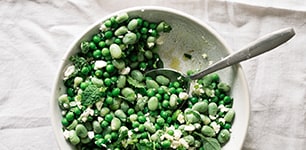 In case you haven’t heard, there’s a wonderful category of foods called pulses that includes beans, lentils, dried peas, and chickpeas, among others. Because pulses deliver a high concentration of fiber, they can provide many potential benefits—perhaps the most important of which is lowering cholesterol when they are part of an overall balanced diet that is low in saturated fat and cholesterol and rich in fruits, vegetables, and grain products.1 Among pulses, beans are a versatile, popular option for getting your fiber intake.
In case you haven’t heard, there’s a wonderful category of foods called pulses that includes beans, lentils, dried peas, and chickpeas, among others. Because pulses deliver a high concentration of fiber, they can provide many potential benefits—perhaps the most important of which is lowering cholesterol when they are part of an overall balanced diet that is low in saturated fat and cholesterol and rich in fruits, vegetables, and grain products.1 Among pulses, beans are a versatile, popular option for getting your fiber intake.
More Than a Hill of Beans
Beans offer a variety of culinary possibilities, which is probably why they’re a dietary staple in so many cultures and countries. Cooked beans may be eaten solo or added to salads and side dishes.2
Cooking Dry Beans
When preparing dry beans, proper soaking ensures that pulses are digestible and nutrients are absorbed.
1) Sort. Start by picking over them and removing any damaged beans, small stones, or dirt.
2) Soak. Most beans will rehydrate to triple their dry size, so be sure to start with a pot that’s large enough to hold them.
Two ways to soak your beans:
- Quick soak – For each pound (2 cups) of dry beans, add 10 cups of hot water. Heat to boiling and let boil 2–3 minutes. Remove pot from heat, then cover and set aside for 1 hour.
- Overnight soak – For each pound (2 cups) of dry beans, add 10 cups of cold water and let soak overnight or at least 8 hours.
3) Cook. Drain water and rinse beans. Cover them with fresh water and simmer for 1.5–2 hours until tender.
Other Tips
- To avoid broken or mushy beans, boil gently and stir very little.
- Taste-test beans often for desired tenderness.
- Foods containing acid—such as tomatoes, chili sauce, lemon juice, vinegar, or ketchup—may slow the cooking and softening of the beans. Include these items near the end so they won’t add to the cooking time.
Canned Bean Shortcuts
If you don’t have the time to cook them from scratch, use canned beans. Look for reduced-sodium or no-salt-added canned beans. Or you can drain and rinse canned beans to reduce the sodium.
Fun fact: Research shows that, across all canned bean varieties and brands tested, the mean reduction in sodium content per serving resulting from draining and rinsing was 41%.3
Now that you have these simple, helpful tips for preparing beans, try to build them into your weekly menus.
Sources:
1"What Are Pulses?" Pulses.org. June 22, 2017.
2United States Department of Agriculture (USDA). "Cooked Beans." What’s Cooking? USDA Mixing Bowl.
March 14, 2012.
3Duyff, Roberta L., John R. Mount, and Joshua B. Jones. "Sodium Reduction in Canned Beans After Draining, Rinsing." BushBeans.com. Originally Published: Journal of Culinary Science and Technology. June 9, 2011.



